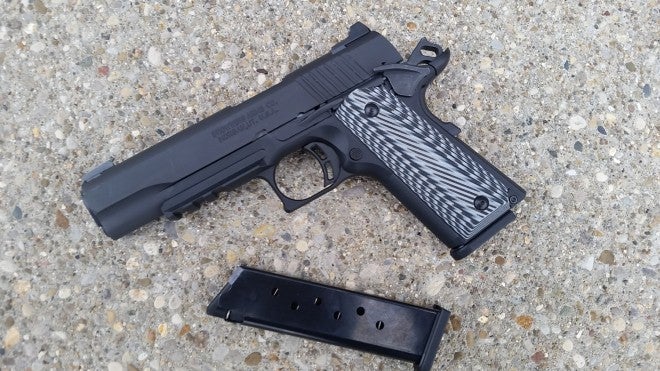Simply curious in what the handgun could be, I requested the editors contact Browning for one of their smaller Black Label .380 1911’s. My initial request was met with skepticism as its known I am not a “1911 guy” (but now have training courtesy of Mr. Larry Vickers) and trepidation as we’ve handled the original model (not a Black Label) and to put it gently, was considered crud. My curiosity is insatiable so I am happy the editors relented and requested the handgun, which turned out a contrary result to originally held opinions.
The Browning Black Label .380 1911 is a well-executed idea of shrinking down a 1911 into a smaller package. It makes a relatively easy to conceal handgun into a slim wunderkund that melts away into even summer clothes. Still, its not the perfection of the idea and the handgun did leave me wanting in a few areas. Curious to know why? Find out below.
Fit, Finish, & Features
The most obvious change from the standard 1911 is the handgun is smaller, noticeably smaller. Browning states its about 80% of its parent .45 design, which has been “right sized” for the caliber. I agree with this assertion. The smaller frame fits easily into ones hands. The slim grips (from the single stack magazine) make it almost child-like for someone used to the larger .45 frame. That said, it makes it entirely easier for those with small hands to operate and use. Everything else is smaller too, the “extended” ambidextrous safeties look diminutive and the extended slide stop is toy-like. Taken as a package, all features feel good compared to another and as an added bonus, those with standard paws can now reach a 1911 slide stop/release without having to break their grip, a boon to slide lock-reloads.
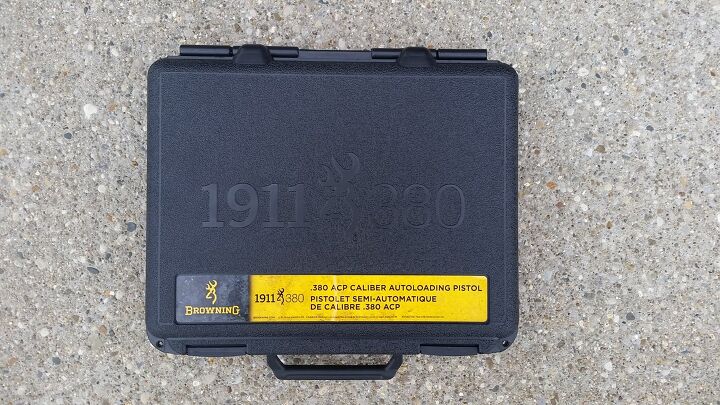
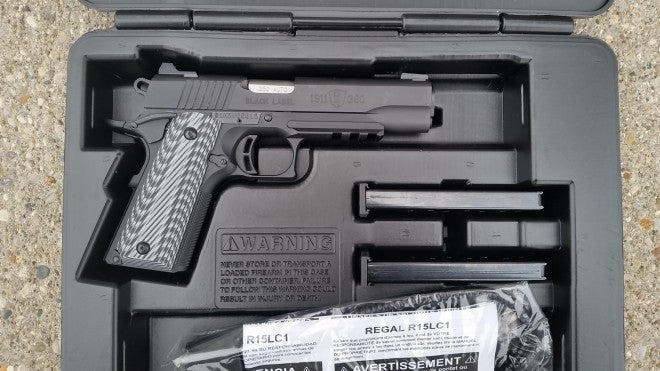
From the outside, the handgun is pure 1911. Everything is where it should be and nothing is out of the ordinary. The front and rear straps on the polymer frame are checkered nicely at about 30 LPI which continues nicely to the beavertail plateau. There is a small undercut behind the trigger guard, and the grips are patterned G10, which has good texture, but is not too aggressive. The hammer is commander style with it, the ambidextrous safety, and slide stop all serrated. Sights are typical 3-dot, also serrated at the rear. No extended or flared magazine well, but it does include a built-in picatinny rail.
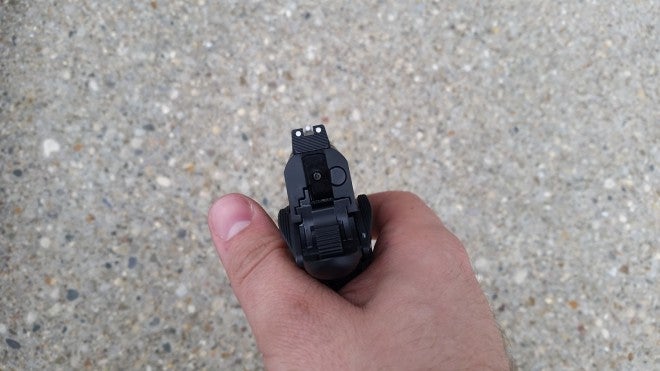
Fit and finish are adequate, but not stellar. Most aficionados of the platform would call it “combat ready” as it seems the clearances between parts accentuates assembly and reliability over the supremely tuned .45 machines. The frame itself is a hybrid injection molded polymer with a metal insert for the frame rails and most of the critical bits are metal. Barrel, bushing, slide, controls, hammer, strut, sights, etc. are all steel. Noticeably, the guide rod, trigger, and mainspring housing are plastic or polymer. The slide itself rattles when shaken, but all the parts within lock up nicely and racking the slide is a smooth, minus a tiny tick when the barrel drops on its cam path.
Breaking down the handgun again follows the .45 procedure but once inside, the differences between the parent platform and .380 child are immediately apparent. The barrel is a link less design that uses slide-stop cut came path. Interestingly, it’s a two-piece affair with the main barrel braised to the chamber area. Also unusual is the barrel hood does not have the standard two lugs for lock-up, which is achieved using only the chamber area, the hood, and link-free slide stop cross member. The recoil spring guide rod is delrin that mates up to the barrel lug using a pin and sunk hole (not more losing guide rods during reassembly!).
While the above are welcome changes so long as the handgun functions, not welcome is the addition of a magazine disconnect, which prohibits firing unless a magazine is present. For this handgun, the mechanism is built in to the beavertail area and has a significant effect on the trigger (more on that later). It can be removed, but Browning will not warranty the handgun afterwards. Also not appreciated is the right side of the ambidextrous safety which is pinned into place versus any of the more traditional mounting methods like using the grip. Detailed stripping of the handgun will require a punch for the small roll pin.
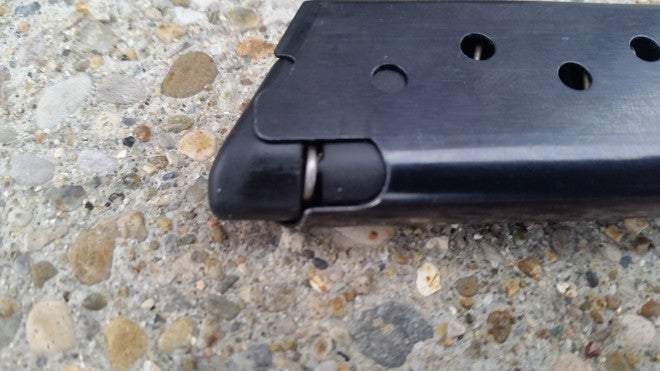
Capacity is 8+1 of any SAAMI spec .380 ACP ammunition. The magazines are a glossy black finish with bullet counting holes on both sides of the single-stack for all 8 rounds. Curiously, the main magazine spring is used to actuate the slide, where it will stick outside of the follower, which can make loading the second round annoying as the spring is forced into the magazine body. The follower and floor plater are plastic. Insertion and removal of the magazines from the frame is smooth. The magazines will drop free at all angles until the frame is parallel to the deck, which they will start dribbling out.
Shooting the Browning Black Label 1911 .380
Sights on the Browning .380 1911 Black Label are an upgraded affair from the base model. Front and rear are dove-tailed, with the rear similar to Novak, but slimmer. When presented on the target, the three white dots line up nicely and are parallel to one another when lined up with the base sights themselves. Both sights use a hex screw to keep them in place and are adjustable for windage only by drifting. Both front and rear are serrated and the rear sight works for one-handed racking, but is not ideal as there are no hard angles.
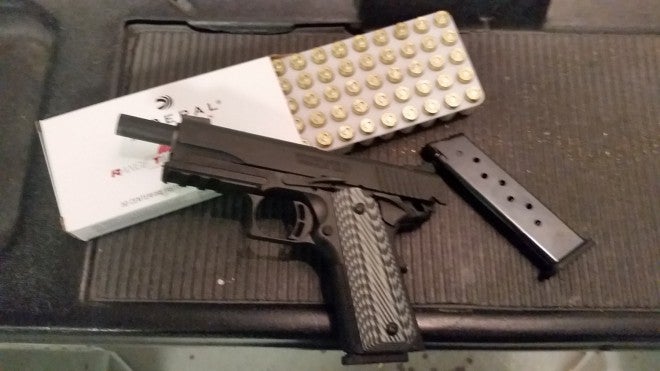
The first range trip with the handgun was a simple affair, putting the handgun through its various paces. Specifically, I wanted to ensure that it functioned with ball ammunition before springing for various (and expensive) defensive loadings, as the 1911 platform is known to be temperamental with various loads. Expecting a few hiccups, especially for a brand new first-generation handgun, I was subsequently bored out of my mind with reliability under range conditions. Using Winchester White Box, magazines or any fill loaded, shot, locked back, and dropped free with ease.
Used to the tame but heavy shove of the .45 1911 and the short snap of pocket pistols, the Browning digested recoil with ease. Similar to its full-size brethren, the handgun is a drawn out impulse and when coupled with the low recoil of its host round, was sublime. Its like walking in to a Mexican joint and waiter advises against a dish as its “too hot” when upon eating it tis only a gentle tingle. Considering I didn’t want hot, I was pleased.
The trigger is almost like a standard 1911, but when coupled to the magazine disconnect is a mushier affair. That said, its heads and shoulders better than any pocket pistol I have tested. The go-pedal is just not as responsive as most 1911’s I’ve shot. Still, its like being in a Mustang, you just have base V6 instead of the GT500. Considering the base V6 is 300+ horsepower, not too shabby.
What stood out most during shooting was the longer sight radius. As long as a full-sized Glock, putting rounds on target was a snap. Shooting at 15 yards, quickly (at least one round/second), groups were no bigger than my hand. Going rapid fire, no bigger than a soccer ball, and that was without real time on the gun.
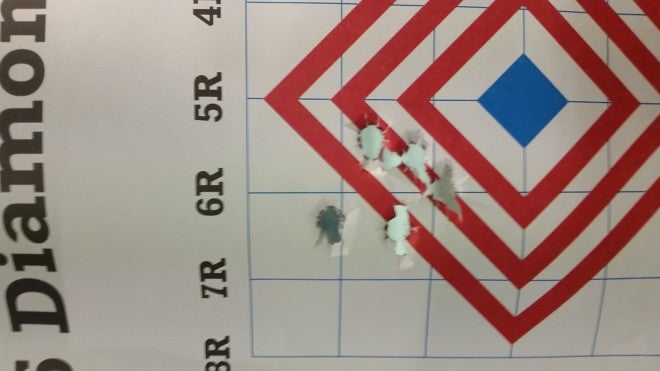
15 yards, off hand.
The only issue I ran into was the slide stop. Like all 1911’s, an extended slide stop has benefits and detractions, but in the case of the 80% sized frame it took special care to ensure a good grip and allow the slide stop to do its job. The same thumb that can easily reach the slide stop to release the slide during reloads can easily keep it from engaging. Make sure to shoot this handgun thumbs up!
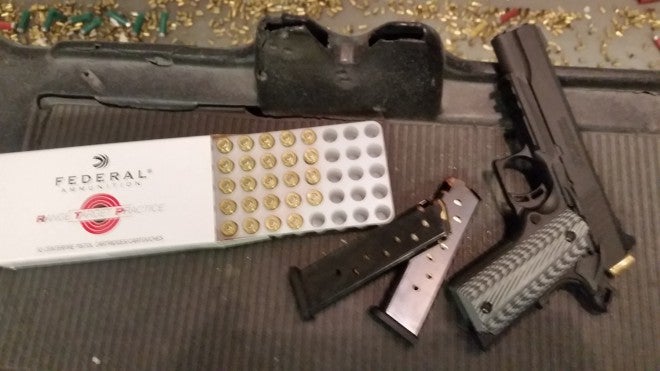
Confident that the handgun was worth the investment of defensive ammunition, I picked up a variety of loads. With me that day includes Federal HST, Hornady, Gold Dots, DRT, and Lehigh Extreme Penetrators. Like the round nose rounds, the defense ammunition fed flawlessly until I started doing reload from concealment drills. Not moving rapidly, slamming a magazine home had the potential of causing one, two or both of an issue. The first was the top round would go nose-up and unseat from the magazine. While annoying and replicated many times, it posed no functional issue as the round never fully unseated from the magazine and releasing the slide always sent it into battery. The second, while rarer, was devastating. If putting forward momentum to ones hand while slamming the magazine, it was possible to unseat the base plate, which would cause the spring, follower, and rounds to fall out the bottom. Fortunately, some home Gunsmithing resolved the issue (I used hot glue but other adhesives would also work) . Recommendation to Browning: increase your magazine spring pressure which can solve both issues.
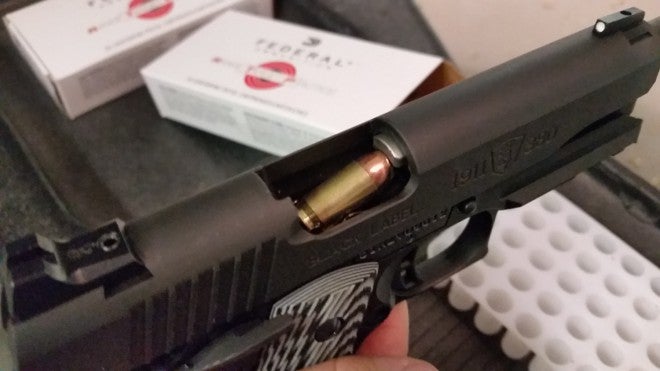
The round was always caught by the barrel hood, so it always functioned. Still, its concerning.
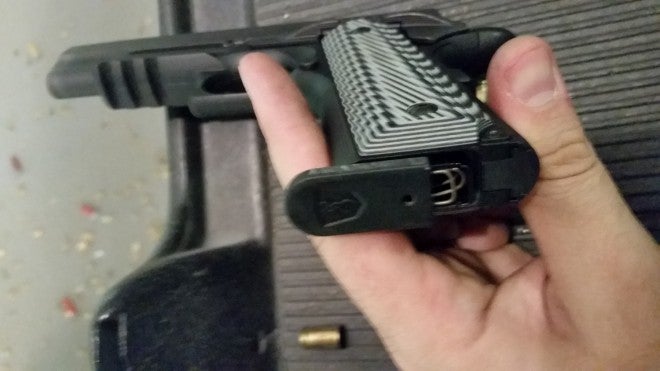
Only flew off once, but went halfway off a few times.
Note- .380 ACP technically does not have a +P SAAMI rating, so one must be careful in choosing over-pressure defensive loads. Browning addresses this in their manual, stating that “The barrel and action of this pistol have been made with substantial safety margins over the pressures developed by established American loads. However, we assume no responsibility for incidents which occur through the use of cartridges of nonstandard dimensions or those developing pressures in excess of SAAMI… established standards. Legally, this is a grey area, as it is almost encouraging someone to try unofficial +P ammo. Shoot at your own risk.
Cognizant of the magazines issues (and now armed with fixed based plates), test firing continued without issue. The handgun handled anything, including mixed loads of bulk and defensive ammunition. I’m used to 1911’s having feeding issues, so it was a real treat. Over 700 rounds went through it over four trips across all loading types.
The Good:
- One of the few times I truly agree with a company’s marketing schtick – it is “right sized”
- Recoil is sorted well. It’s a large handgun for the caliber and with the long sight radius is easy to double-tap.
- Light, slim platform is extremely easy to conceal. Front and backstraps molded to 30 LPI checkering and G10 grips are not too grippy.
- At all types of .380 fed to it including round nose, hollow-points, and machined-copper rounds.
- 4” barrel for .380 gives it extra velocity that the caliber uses well.
The Notable:
- In terms of fit and finish, I would call this a “combat ready” handgun. Slide rattles when shaken. Finishes wearing easily.
- Decent trigger capable of being turned great with a trigger job.
- Vigorously inserting a magazine will cause a round to go “nose-up” but never affected function.
- Magazines have finally matriculated through the distribution stream but retail at $42!
- Lower is polymer construction. Barrel is linkless, and recoil rod looks like delrin.
- The system uses its magazine spring to actuate the side stop. Interesting design choice.
- Browning declares the handgun is made with “substantial safety margins” for the unofficial +P ammo, but disclaims any failures due to overpressure ammo. Nifty legal trick, but would have been better to at least rate the PSI its capable of handling.
The Bad:
- Magazine disconnect. Why in the sam-heck Browning opted to include it is beyond me. It turns a great trigger into a decent one.
- Proprietary sight system. In today’s world with various systems firmly established and functional (especially for 1911’s), proprietary is dumb.
- Magazine bases can become separated during vigorous reloading. While this can be fixed with some home Gunsmithing, its disconcerting from the factory.
Final Thoughts:
The Browning .380 1911 Black Label is truly an excellent idea. Its lightweight, slim, easily concealed, and has hands-down the best .380 trigger I have ever shot. The long sight radius is a boon to shootability and when coupled with the extremely tame recoil, it’s a breeze to put an entire magazine into a silhouette at 15 yards. My best groups at that distance were about the size of my hand – with the best actually being during a rapid fire string.
However, I have the opinion that the handgun is not everything it could be. While it includes the nice ambidextrous safety and an extended slide stop, at this price point there should be front serrations on the slide, a single-piece barrel, better finishes, and a complete removal of the magazine disconnect. (I mean, Ruger can sell a complete machined steel .45 1911 for the same price with better finishes, thought fit would be the same) Added bonus would be a flared magazine well. From there, the proprietary sight cuts really strike a nerve, I can understand these omissions and oversights on the base handgun, but as soon as Browning created their obstentiably high-end “Black Label” brand, these should have been included or put to bed.
Despite the criticisms, it’s by far the best .380 that I have had the pleasure to shoot. Having reviewed the Glock 42 .380, the 1911 .380 stands out far and above as the better shooting handgun though the Glock kicks its tail in fit and finish. I’m personally frustrated at what the handgun could have been yet find it perfectly suitable for what it needs to do. This is a difficult mental dichotomy that was only reconciled by myself purchasing the handgun from Browning, which means, at least to me, that it measured up on what counts.
Now, having wrapped up the review of the .380, in my humble (yet loud) opinion Browning NEEDS to make this in 9mm. Unlike the Glock 42 to Glock 43, where the move to 9mm soiled a perfectly good platform, 9mm is exactly what the 80%-sized platform needs to shine.
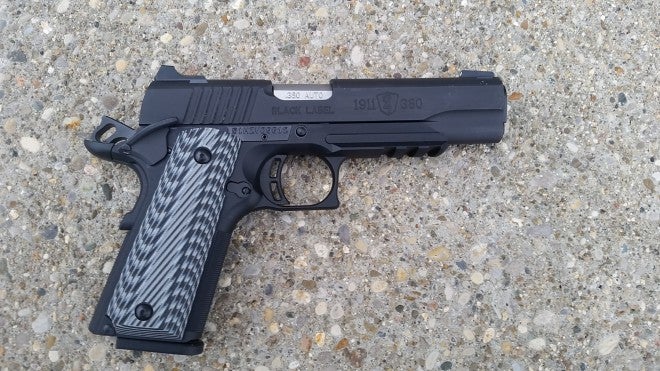
 Your Privacy Choices
Your Privacy Choices
